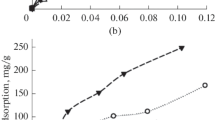Abstract
In experiments with strains of poliovirus, reovirus, echovirus, and Coxsackievirus, overgrowth with exopolymer-forming bacteria reduced virus adsorption to mineral surfaces. Adsorption was improved when organic materials adsorbed to minerals were removed by low-temperature ashing. In a soil series, virus adsorption increased with soil depth. This paralleled a decrease in organic content, but differences in charge development of the soil particles may also be involved. Prolonged (40-year) irrigation with treated sewage effluents, leading to a buildup of organic coatings, also decreased adsorption. However, saturation of the virus-binding capacity of the soil as a result of continuous exposure to virus-containing effluents was not apparent.
Similar content being viewed by others
References
Bitton G, Masterson N, Gifford GE (1976) Effect of a secondary treated effluent on the movement of viruses through a cypress dome soil. J Environ Qual 5:370–375
Bitton G, Pancorbo O, Gifford GE (1976) Factors affecting the adsorption of poliovirus to magnetite in water and wastewater. Wat Res 10:973–980
Bixby RL, O'Brien DJ (1979) Influence of fulvic acid on bacteriophage adsorption and complexation in soil. Appl Environ Microbiol 38:840–845
Burge WD, Enkiri NK (1978) Virus adsorption by five soils. J Environ Qual 7:73–75
Daley RJ, Hobbie JE (1975) Direct counts of aquatic bacteria by a modified epifluorescence technique. Limnol Oceanogr 20:875–881
Drewry WA, Eliassen R (1964) Virus movement in groundwater. J Wat Pollut Control Fed 40:R257-R271
Farrah SR, Unz RF (1976) Isolation of exocellular polymer for Zoogloea Strains MP6 and 106 and from activated sludge. Appl Environ Microbiol 32:33–37
Friedman BA, Dugan PR, Pfister RM, Remsen CC (1968) Fine structure and composition of the zoogloeal matrix surroundingZoogloea ramigera. J Bacteriol 96:2144–2153
Fuhs GW, Taylor DH (1982) Virus uptake by minerals and soils. In: Middlebrooks EJ (ed) Water reuse. Ann Arbor: Ann Arbor Science, Ann Arbor, Michigan, pp 603–639
Hinesly TD, Thomas RL, Stevens RG (1978) Environmental changes from long-term land applications of municipal effluents. EPA Technical Report, EPA/430/9-78/003 (or EPA/ MCD-26)
Lipson SM, Stotzky G (1983) Adsorption of reovirus to clay minerals: effect of cation exchange capacity, cation saturation, and surface area. Appl Environ Microbiol 46:673–682
Lo SH, Sproul OJ (1977) Polio-virus adsorption from water onto silicate minerals. Wat Res 11:653–658
Moore RS, Taylor DH, Sturman LS, Reddy MM, Fuhs GW (1981) Poliovirus adsorption by 34 minerals and soils. Appl Environ Microbiol 42:963–975
Moore RS, Taylor DH, Reddy MM, Sturman LS (1982) Adsorption of reovirus 3 by minerals and soils. Appl Environ Microbiol 44:852–859
Oza PP, Chaudhuri M (1975) Removal of viruses from water by sorption on coal. Wat Res 9:707–712
Renn CE (1964) The bacteriology of interfaces: principles and applications in aquatic microbiology. In: Heukelekian H, Dondero NC (eds) Proceedings of the 1963 Rudolfs Research Conference at Rutgers University. Wiley, New York, pp 193–201
Scheuerman PR, Bitton G, Overman AR, Gifford GE (1979) Transport of viruses through organic soils and sediments. J Environ Eng Div ASCE 105:629–640
Taylor DH, Moore RS, Sturmann LS (1981) Influence of pH and electrolyte composition on adsorption of poliovirus by soils and minerals. Appl Environ Microbiol 42:976–984
Tezuka YA (1978)Zoogloea bacterium with gelatinous mucopolysaccharide matrix. J Wat Pollut Control Fed 45:531–536
Tofflemire TJ, Chen M (1978) Evaluation of phosphate adsorption capacity and cation exchange and related data for 35 common soil series in New York State. Technical Report no. 45. New York State Department of Environmental Conservation, Bureau of Water Research, Albany, New York, 300 pp
US Department of Agriculture Soil Conservation Service (1972) Soil Series of the United States, Puerto Rico and the Virgin Islands: their taxonomic classification. US Dept Agric Soil Cons Service, Washington, DC
Ware GC, Loveless JE (1958) The construction of biological film in a percolating sewage filter. J Appl Bacteriol 21:308–312
Wilson DE, Kinney P (1976) Effects of polymeric charge variations on the proton-metal ion equilibria of humic materials. Limnol Oceanogr 22:281–289
Author information
Authors and Affiliations
Rights and permissions
About this article
Cite this article
Fuhs, G.W., Chen, M., Sturman, L.S. et al. Virus adsorption to mineral surfaces is reduced by microbial overgrowth and organic coatings. Microb Ecol 11, 25–39 (1985). https://doi.org/10.1007/BF02015106
Issue Date:
DOI: https://doi.org/10.1007/BF02015106



